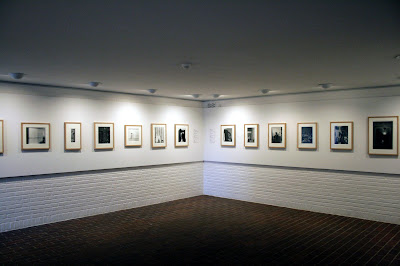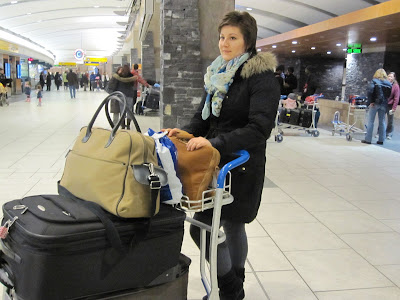I spent 3 days in Copenhagen before flying out from Københavns Lufthavn.
On my first day, I took the train north to the Louisiana Museum of Modern Art located in Humlebæk, Denmark. Louisiana is an international museum with a considerable collection of modern art. The museum’s permanent collection includes more than 3000 works and is one of the largest in Scandinavia. The museum frames the sculpture park facing the sea and the interaction between art, nature and the museum architecture is quite unique. Unfortunately, due to icy walkways, the sculpture park was closed during my visit.
 |
| The Museum |
 |
| backed onto the sea |
 |
| Per Kirkeby, 1967 |
 |
| Per Kirkeby, 1967 |
 |
| Per Kirkeby, 1967 |
 |
| Ugo Rondinone, THIRTYFIRSTMAYTWOTHOUSANDANDONE, 2001 |
 |
| Josef Albers |
 |
| Jan Schoonhoven, 1969 |
 |
| Jesús Rafael Soto, Virtual Purple Square, 1979 |
 |
| Jesús Rafael Soto |
 |
| Wassily Kandinsky, In The Free Blue, 1929 |
 |
| Jackson Pollock, Untitled, 1944 |
 |
| Arnold Newman, Black and White photography - Portraits |
On day 2, I first visited the Danish Design Centre (DDC) in Copenhagen. The DDC permanent exhibition consists of a number of design icons from Denmark and the world. The centre also puts on a number of special exhibitions each year.
The main exhibition '10+ Design Forecast' accesses Danish design in the first ten years of the new millennium and examines which design trends have a big role to play in the years to come.



 |
Good design isInnovative
An innovative design can be a ‘break-through’ product or service, but it can also be a re-design of an existing product or service. A ‘break-through’ product offers the market and the user a new and previously unseen function and added value, while a re-design improves on an existing product.
Functional
Functional design is intended to serve a function – preferably a primary and a supplemental function. A functional design solves a problem, and in its design it optimises a given function.
Aesthetic
An aesthetic product has an inherent power of fascination and an immediately accessible sensuous quality.
Intuitive
Intuitive design is self-explanatory and thus often negates the need for a user manual. It is obvious how the design should be used, perceived and understood. The design explains the function.
Good business
Good design is competitive and stands out in a competitive market. Good business means a healthy bottom line – hence, good design is also a product or a service that sells well.
Honest
An honest design only communicates the functions and values it actually offers. It should not manipulate buyers or users into thinking that it offers more than it does.
Durable
In a society characterised by excessive consumption, good design serves an important purpose. It is based on durability in the sense that the design and the materials have staying power rather than just representing a fad. Waste and excessive consumption are not aspects of good design.
Responsible
Good design is responsible, among other things by considering environmental concerns. For example, it may contribute to a cleaner and more sustainable world, where materials have high durability and may even be recycled in new contexts.
Shaped and styled
Shape and appearance are essential aspects of good design. They are the basis for creating and designing. Shaping and styling ensure an attractive sensuous quality and an added value.
User oriented
Good design focuses on the user and aims to improve a given situation for the user. User-oriented design provides an added value, whether material or immaterial, and thus increases the user’s satisfaction and life situation. |
The upstairs exhibition 'The Danish Design Prize 2010/11' shows Danish design at its very best. The Danish Design Prize is awarded to companies that have created innovative products and solutions of a high aesthetic and functional quality, thus contributing to highlighting the value and stimulating the use of design.
In the exhibition, visitors are able to explore the prize-winning products and solutions, listen to interviews with the prize-winners and watch film clips where various users comment on the winning products.
The exhibition in the lower level, 'Denmark by Design' shows the development in Danish design from 1945-2010.
And, some cute ceramics in the gift shop...
I then made my way to The Danish Museum of Art & Design. The museum brings together and documents the contemporary developments within industrial design, decorative and applied arts.
 |
| The Textile Study Room |
 |
| The China exhibition |
 |
| European Renaissance |
 |
| French Rococo |
 |
| The English Room |
 |
| Meissen porcelain |
 |
| Steffen Dam |
 |
| Lone Skov Madsen, 1997 |
 |
| Works by Thorvald Bindesbøll |
 |
| Jorgen Hovelskov, 1963 |
 |
| 'The Best from 100 Years' exhibition |
 |
| Henrik Vibskov, Piggy suit plus bag, 2001 |
 |
| Finn Juhl chair and drawings |
 |
| Lamps by Verner Panton |
 |
| Nimbus motor bike |
 |
| Ettore Sottsass, 1982 |
 |
| Steffen Dam, 2001 |
 |
| Lino Tagliapietra, Vase, 1987 |
 |
| Bente Hansen, stoneware, 2003 |
 |
| Camilla Prasch, necklace, 2002 |
 |
| The Design Studio |
 |
| The Study Collection |
I then took the Metro to Field's shopping mall, where I spent the remainder of the evening :)
















































































